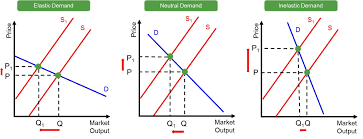Economics Alevel OCR Topic 2.6 Elasticity (PED ONLY)
1/25
Earn XP
Description and Tags
(microeconomics paper 1) (this is only price elasticity of demand, there are sperate decks for the rest)
Name | Mastery | Learn | Test | Matching | Spaced |
|---|
No study sessions yet.
26 Terms
what is elasticity?
the measurement of the sensitivity of one variable in response to a change in another variable
what is price elasticity of demand? (ped)
a measure of the responsiveness of quantity demanded given a change in price
what’s to formula for ped?
percent change in quantity demanded/percent change in price
how do we remember this formula?
queue before you pee! q for quantity and p for price
does the number for ped have any units?
no
what symbol is always in front of the ped value?
the negative symbol, this DOES NOT MAKE PED NEGATIVE
why is ped always negative?
because of the inverse relationship between price and quantity. As one rises the other falls so ped will always turn out to be negative
what does it mean if ped is above 1?
demand for the good is price elastic
what does it mean if the value for ped is below 1?
demand for the good is price inelastic
what does it mean if ped equals 0
price is perfectly elastic
what does it mean if demand if infinite/recurring?
demand is unit price elastic (not sure what this even mean)
what does it mean if ped is inelastic?
there’s lesser proportionate amount demanded
what type of curve do we draw if ped is inelastic?
a very steep demand curve
look in book for rest

how to remember the factors that influence ped?
SPLAT
What does S stand for?
number of substitutes→ the more there is the more elastic demand/ped will be→ more alternatives available for a product
e.g. if pringles price increases there’s alternative brands so people won’t buy pringles, meaning that its price effects demand so its ped elastic
what does the p stand for?
proportion of income→ if a price change in a good takes up a great proportion of your income the more price elastic demand will be→ people less willing to buy if it takes up a lot so price will greatly effect demand, making the good/ demand ped elastic
what does the L stand for?
luxury or necessity
if luxury good→ ped will usually be elastic→ if price increases in these then demand will most likely fall and will fall by a greater proportionate amount as people don’t need these products and usually won’t buy them no matter what→ e.g. chocolate and soft drinks
if necessity good→ ped will usually be inelastic→ if price increases then demand will fall be a lesser proportionate amount as people need to product and will buy it no matter what→ e.g. petrol, water, electricity
what does the A stand for?
addictive→ ped is usually inelastic for these goods→ demand for these goods will fall by a smaller proportionate amount if price is increased as people are addicted and will buy them no matter what→ e.g. cigs
the more addictive the more inelastic
what does the T stand for?
Time→ over time goods will become more elastic as over time more substitutes become available
how does PED help firms?
it helps them determine their pricing strategy as they can see how demand responds to price and how it will affect their revenue
what happens when demand for a good is inelastic and there’s an increase in price?
there’s an increase in total revenue and vice versa (pls check book for this)
what happens if PED for a good is inelastic and there’s a fall in price?
total revenue will increase (Again check book)
how to remember the effects of price on revenue?
EOIS
what does it stand for?
Elastic Opposite Inelastic Same
what does this mean?
when demand is elastic, the opposite of whatever happens to price will happen to revenue
when demand is inelastic, the same thing that happens to price will happen to revenue
how is PED useful to governments?
they can understand the burden of taxation on producers and consumers. The more price inelastic a good is, a greater proportion of the tax is paid by the consumer than producer